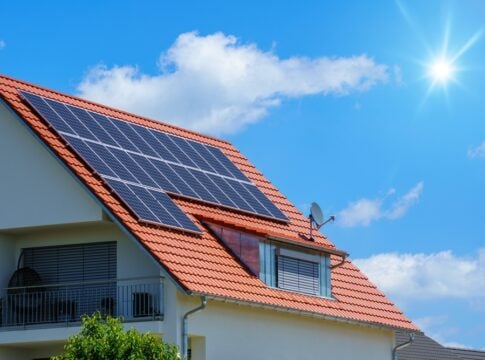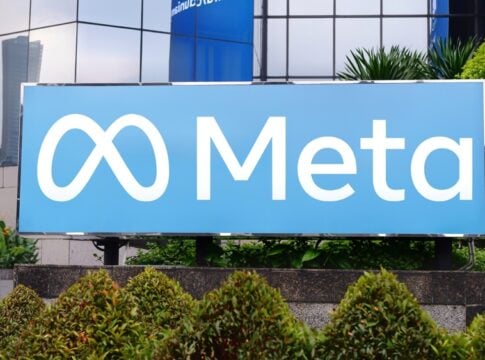Carbon Footprint
U.S. Residential Solar in 2025: Market Slowdown Now, but 2050 Forecast is Massive
The U.S. residential solar market is uncertain. Its long-term potential is huge, exceeding current U.S. power generation capacity. However, recent policy changes threaten short-term growth.
Wood Mackenzie’s analysis, “Near-term challenges but long-term potential: evaluating the US residential solar addressable market,” shows how the One Big Beautiful Bill Act (OBBBA) affects homeowners and solar developers. The main concern is the removal of the Section 25D Investment Tax Credit (ITC) for customer-owned systems starting in 2026.
The U.S. Residential Solar Stumbles in Tough Climate
According to the SEIA Q2 solar report, residential solar installations fell sharply in Q1 2025. Homeowners installed 1,106 MWdc of capacity. This is a 13% drop from Q1 2024 and 4% lower than Q4 2024.
High interest rates, economic uncertainty, and upcoming changes to federal tax credits are slowing demand. California remains the top solar state with 255 MWdc installed, but this is its weakest performance since Q3 2020.
More than 20 states saw installation declines. Puerto Rico and Florida follow California, but nationwide momentum has stalled.

OBBBA Shakes Up an Already Fragile Solar Policy
The OBBBA introduces significant policy uncertainty. The removal of the Section 25D credit has made solar less affordable for homeowners. While third-party-owned (TPO) systems can still qualify for credits under Section 48, they now face new restrictions like compliance with “foreign entity of concern” (FEOC) rules.
An executive order issued on July 7 adds to the confusion and may limit TPO system eligibility for incentives.
Additionally, the House passed a budget reconciliation bill on May 22. This bill could eliminate tax credits for both customer-owned and leased solar systems starting in 2026. Though it passed narrowly, it faces Senate negotiations, where amendments could change its impact.
Sunny Horizon Yet Cloudy Now
Due to rising policy and economic challenges, the five-year outlook for residential solar has been cut by 9%. Installers report significant disruption, and consumer demand is softening amid uncertainty around tariffs and future tax incentives.
Despite these challenges, the market’s potential is enormous. By the end of 2024, only 7.5% of suitable U.S. homes had solar installed. Wood Mackenzie forecasts that, barring setbacks, the residential solar segment could grow 9% annually through 2030 and reach a 13% penetration rate.
However, these figures do not account for OBBBA’s full impacts. In a worst-case scenario, assuming the loss of all tax credits and high interest rates, adoption could drop 46% below baseline projections by 2030.
- READ MORE: US Solar Market Slows in 2025 – Here’s How SolarBank (NASDAQ: SUUN) Is Still Gaining Ground
Can the Solar Market Recover Without Tax Credits?
Looking ahead, the key question is how solar companies will adapt without the Section 25D ITC. Many smaller players may not survive the transition, especially if TPO options become less viable.
Industry veterans expect surviving companies to change. Homeowners might find solar appealing due to lower system costs, new financing options, and rising electricity bills. Concerns about resilience and energy independence may also increase adoption.
Even in the most pessimistic forecast, the U.S. residential solar market is expected to rebound after 2028 and add at least 150 GWdc by 2050.
Looking Ahead to 2050: Residential Solar’s Next Frontier
The solar industry’s long-term outlook is promising. With electricity demand expected to rise and the push for energy independence growing, solar remains a top solution for decarbonizing the residential sector.
By 2050, solar will play a vital role in how Americans power their homes. While only 7.5% of suitable homes had solar by the end of 2024, that number could increase significantly if conditions align.
Key growth drivers toward 2050 include:
-
Retail electricity rate hikes: Rising utility rates may lead more homeowners to adopt solar.
-
Battery storage adoption: Pairing solar energy with affordable home batteries can help solve intermittency issues and unlock significant savings.
-
State policy momentum: Even if federal support wanes, state-level incentives and renewable mandates could keep driving adoption.
-
Technological advances: More efficient panels, easier installations, and longer warranties will boost solar’s appeal.
Business Models Will Evolve
If traditional customer-owned systems lose their tax advantages, solar companies may pivot to new business models. Community solar, subscription-based plans, and solar-as-a-service may gain traction. These models allow broader participation, especially among renters and low-income households.
Digital platforms that streamline financing, permitting, and installation could cut costs, making solar feasible even without generous tax credits.
1,494 GWdc: A Market Bigger Than the Grid
Despite current challenges, the long-term market size is impressive. Wood Mac says, by 2050, there will be about 92 million owner-occupied single-family homes in the U.S. Excluding homes with solar already and those not suitable for installation, around 70 million homes could still get solar upgrades.
If average system sizes continue to increase, this leads to a total addressable market (TAM) of roughly 1,494 GWdc, exceeding the current U.S. electricity generation fleet of around 1,300 GW.
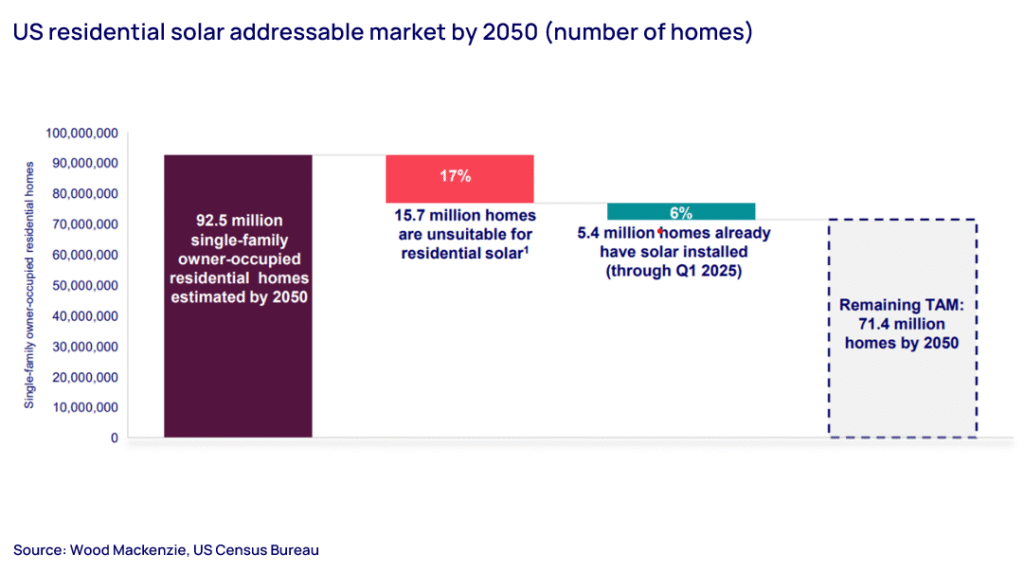
Will Solar Reach Its Full Potential?
Wood Mackenzie’s “low case” scenario suggests only 12% of the total addressable market may be reached by 2050. However, this might be too cautious. Over the next 25 years, innovation, lower costs, and new business models could greatly increase market penetration.
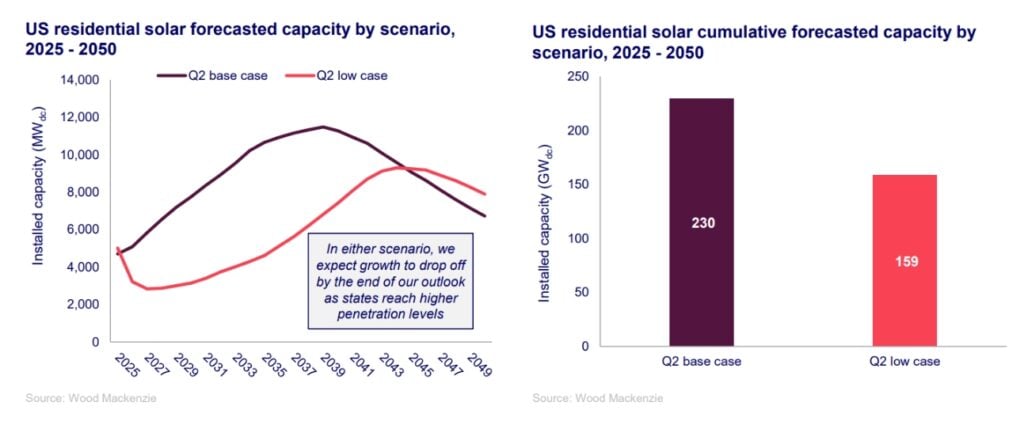
Under favorable conditions, the market might reach a penetration of 30–40%. If the average system size grows as expected and costs drop below grid parity, growth could speed up.
In summary, the 1,494 GWdc TAM won’t be fully captured, but even partial adoption could add hundreds of gigawatts of clean capacity.
Overall, the long-term picture is compelling. With a TAM that exceeds the U.S. power generation fleet, the opportunity is immense. Even modest adoption could reshape the residential energy landscape by 2050.
The next few years will test the resilience and agility of solar companies. Those that survive will likely power a cleaner, more self-sufficient future for millions of American homes.
The post U.S. Residential Solar in 2025: Market Slowdown Now, but 2050 Forecast is Massive appeared first on Carbon Credits.
Carbon Footprint
From Steel to Mass Timber: Meta’s Low-Carbon Data Center Makeover
Data centers are usually built with carbon-heavy materials like concrete and steel. However, cement and steel production together contribute to about 15% of global carbon emissions. That makes them key targets for climate action. To reduce this impact, Facebook owner Meta announced that it is turning to mass timber.
So what’s mass timber? It’s a strong, engineered wood that has a much lower carbon footprint. Unlike steel and concrete, mass timber stores carbon absorbed by trees during their growth.
From Steel to Timber: Meta’s Smart Shift in Construction Materials
Meta is rapidly expanding its global infrastructure. But with growth comes responsibility. The company has committed to reaching net zero emissions across its value chain by 2030. This includes Scope 1, Scope 2, and Scope 3 (emissions from suppliers, construction, travel, and product use).
To meet this goal, Meta is acting on all fronts. One major step is rethinking how it builds its data centers. Notably, this move is a major step toward targeting Scope 3 emissions tied to building construction and materials.
In 2023, its market-based net emissions were about 7.5 million metric tons of CO₂e, while location-based emissions stood at 14 million metric tons. However, the company has maintained net zero emissions in its global operations since 2020, cutting emissions by 94% from 2017 levels.
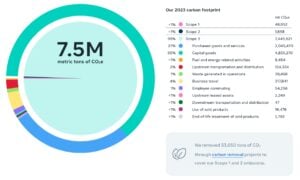
This year, Meta started using mass timber at its data center campuses. And the company’s first mass timber office building was completed in Aiken, South Carolina, with more projects underway in Cheyenne, Wyoming, and Montgomery, Alabama.
Check out the video here:
Why Mass Timber Matters for the Planet
Mass timber offers multiple environmental and operational benefits. For example:
- It can cut embodied carbon by about 41% compared to traditional materials.
- Since timber products are prefabricated, construction times are shorter and on-site emissions are lower.
- The material’s lighter weight reduces the need for deep concrete foundations—further reducing carbon impact.
Moreover, this approach significantly reduces Scope 3 emissions from construction activities, while also supporting Scope 1 and 2 targets through smarter, cleaner infrastructure operations.
Strength, Safety, and Speed in One Material
Beyond its climate advantages, mass timber is strong and fire-resistant. Engineered to handle industrial use, it meets the safety standards required for large-scale buildings like data centers. Its high strength-to-weight ratio means it can even outperform steel in some applications.
Additionally, mass timber can be pre-insulated and customized for use in walls, roofs, and floors. When exposed indoors, it contributes to biophilic design, a building style that connects people with nature and boosts workplace morale and well-being.
Responsible Sourcing for a Greener Future
Meta is also focused on ensuring that the timber it uses is sustainably harvested. It requires third-party audits to verify that the wood is traceable back to responsibly managed forests. These audits ensure that forests are protected for long-term health and that timber operations uphold fair labor practices and community benefits.
In certain cases, reclaimed wood is used to avoid new harvesting altogether—helping further reduce Scope 3 emissions tied to raw material sourcing.
Partnering for Climate-Smart Forestry
In addition to using sustainable timber, Meta is investing in nature-based carbon removal projects that benefit both people and the planet.
For instance, the company partnered with BTG Pactual Timberland Investment Group in Brazil to support a major reforestation effort. This long-term agreement will deliver up to 3.9 million carbon removal credits through 2038—helping offset residual emissions that cannot be eliminated, particularly in Scope 3.
These credits come from a $1 billion Latin America forestry strategy, guided by Conservation International to ensure biodiversity and social equity.
Besides using low-carbon building materials, Meta is embedding circularity into its data center hardware lifecycle, further cutting Scope 1 and Scope 3 emissions.
A key example is Meta’s use of lithium-ion battery backup units (BBUs), which replaced older lead-acid versions starting in 2014. These new batteries last longer, take up less space, and are easier to monitor and reuse.
By tracking battery health, the tech giant determines which units are suitable for reuse—even after hardware decommissioning. Currently, about 95% of BBUs are eligible for reuse, and this is expected to climb to 98% as diagnostics improve. Unused components are recycled responsibly, keeping valuable materials in circulation and reducing demand for virgin resources.
Additionally, the company is working with the iMasons Climate Accord (iCA) and the Open Compute Project (OCP) to tackle the issue of embodied carbon in data centers. The goal is to create a standard, transparent way to measure and report the carbon emissions tied to building and running data centers.
This new framework will help operators understand their carbon footprint better and make smarter choices to cut their environmental impact.
Scaling Up: Timber Pilots Show the Way
While building with mass timber has clear benefits, scaling it across the data center industry remains a challenge. However, the company’s pilot projects serve as real-world models for how to do it successfully.
As Meta continues to grow, it is committed to scaling low-carbon building strategies to tackle emissions in all three scopes.
As said before, the emissions generated from making and transporting steel and concrete are far higher than those from mass timber. By choosing bio-based, sustainable materials, Meta shows how tech companies can build smarter, cleaner, and more climate-resilient digital futures.
- ALSO CHECK: Facebook Owner Meta Stock Surges After Beating Q2 Forecasts and Sustainability Milestone Progress
The post From Steel to Mass Timber: Meta’s Low-Carbon Data Center Makeover appeared first on Carbon Credits.
Carbon Footprint
DevvStream Bets $10M on Bitcoin and Solana to Reinvent Carbon Credit Markets
DevvStream Holdings Inc., a publicly traded carbon management and technology company, has taken a bold step into the world of digital assets. The company announced it will use $10 million from its first financing round to buy digital currencies like Bitcoin and Solana. This strategy helps DevvStream’s long-term goal. It aims to use blockchain tech to digitize and grow the global carbon credit market.
The funds come from the first tranche of a much larger $300 million convertible note facility, provided by Helena Partners. DevvStream plans to speed up the growth of tokenized carbon credit systems. They will do this while keeping share dilution low for existing investors. This latest development positions DevvStream at the intersection of sustainability, finance, and technology.
Building a Blockchain Treasury: Why Bitcoin and Solana?
DevvStream’s newly launched crypto treasury will include Bitcoin (BTC), Solana (SOL), and the company’s own DevvE token. Each digital asset plays a different role in the company’s overall strategy.
- Bitcoin
Bitcoin is being used as a reserve asset. This cryptocurrency is known for its limited supply and wide use. This gives DevvStream a stable and liquid foundation. Its role in the treasury is to provide long-term value. It also acts as a financial cushion, separate from traditional markets.
- Solana
Solana, on the other hand, is being used for its technical utility. Known for fast transaction speeds and low fees, Solana’s blockchain provides the flexibility DevvStream needs to power smart contracts and digital token systems. It will play a central role in enabling the real-time creation, exchange, and settlement of tokenized carbon credits.
- DevvE
Finally, DevvE—the company’s native utility token—will serve as the bridge between environmental assets and blockchain infrastructure. DevvStream plans to use DevvE to create financial tools. These tools will help trade, monitor, and verify carbon credits and other sustainability assets on the blockchain.
These digital assets give DevvStream a varied crypto base. In turn, this base helps ensure financial security and supports platform functionality. The company noted:
“This $300 million facility allows us to improve capital efficiency, reduce dilution, and bring global investors into the carbon ecosystem through a digital gateway. The combination of crypto reserves and real-world asset tokenization represents the next evolution of our capital strategy.”
Tokenizing Carbon Credits and Real-World Environmental Assets
At the core of DevvStream’s strategy is the tokenization of carbon credits and related environmental assets. Tokenization turns real-world assets, like a certified carbon offset or a clean energy project, into digital tokens. These tokens can be issued, traded, and tracked on a blockchain.
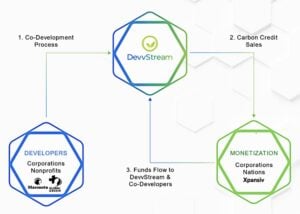
This move is designed to bring transparency, liquidity, and speed to carbon markets, which are criticized for being slow, opaque, and fragmented. DevvStream thinks that by tokenizing these credits, it can help investors. This will improve access, ensure quality and traceability, and lower transaction costs.
The company is not only focused on carbon credits. It is also looking into tokenizing renewable energy infrastructure. This includes solar farms and battery storage systems.
These real-world assets could turn into digital investment products. This change could create new ways to finance clean energy development.
With this, DevvStream is not just making digital currencies; it is also building a new model for sustainable finance. This model links environmental impact with digital market infrastructure.
Trust and Tech: Safeguarding the Digital Green Future
DevvStream has chosen a regulated digital asset custodian. This helps them manage their crypto treasury safely and professionally. It has also partnered with a digital asset adviser to oversee treasury operations and ensure compliance with financial and regulatory standards.
DevvStream’s approach shows it is dedicated to building a strong and secure base for its digital finance strategy. It also helps build trust with investors and partners who may still be cautious about cryptocurrency exposure.
The company’s stock responded positively to the announcement. Shares jumped after the news. This shows that investors trust DevvStream’s plan to mix sustainability with blockchain innovation.
The treasury allocation is just the beginning. DevvStream will use more funds from the $300 million facility. They plan to boost their blockchain capabilities, support new sustainability projects, and launch their full token platform worldwide.

A Glimpse Into the Future Where Climate Goals Meet Crypto Gains
DevvStream’s decision to combine carbon management with digital assets reflects a growing trend in climate finance. More companies see how blockchain can fix old problems in the carbon market. These issues include double counting, poor transparency, and limited access.
As a result, the voluntary carbon market, though valued at around $4 billion in 2024, still operates far below its potential.
The issue of double counting alone may affect up to 30–40% of reported GHG reductions, undermining trust in climate claims. Also, carbon markets are often broken up, unclear, and depend on many brokers and registries.
Blockchain solves these issues with features like:
-
Tamper-proof tracking
-
Real-time updates
-
Automated credit retirement
-
Tokenizing real-world assets, such as carbon offsets
These systems make it easier to trace the origin and ownership of each credit, reduce fraud, and lower transaction costs. They expand access by allowing fractional ownership. This allows more people and companies to take part.
The market for blockchain carbon credit certification is growing fast. It could jump from about $884 million–$1.06 billion by 2030.

By combining carbon management with digital assets, DevvStream is tapping into this momentum—helping build a more open, liquid, and trustworthy carbon credit market.
A Digital Pathway to Real Climate Impact
With blockchain, each token can carry data about the origin, verification, and impact of a carbon credit. Investors can see where their money goes and what environmental results it supports. This level of clarity is difficult to achieve in traditional markets but becomes possible with digital tools.
In the long run, this approach could allow sustainability projects—from reforestation efforts to clean transportation systems—to raise capital faster, more efficiently, and with full transparency. It also helps align financial returns with climate goals, providing a win-win for investors and the planet.
DevvStream’s $10 million investment in Bitcoin, Solana, and its own token isn’t just about treasury management. It shows the future direction of sustainable finance.
The company is using digital assets and blockchain. This creates a platform for carbon credits and environmental projects, where they can work quickly, reliably, and openly. With this strategic move, DevvStream is not just participating in the future of clean finance. It is helping to define it.
The post DevvStream Bets $10M on Bitcoin and Solana to Reinvent Carbon Credit Markets appeared first on Carbon Credits.
-
Climate Change2 years ago
Spanish-language misinformation on renewable energy spreads online, report shows
-
Climate Change Videos2 years ago
The toxic gas flares fuelling Nigeria’s climate change – BBC News
-

 Greenhouse Gases1 year ago
Greenhouse Gases1 year ago嘉宾来稿:满足中国增长的用电需求 光伏加储能“比新建煤电更实惠”
-

 Climate Change1 year ago
Climate Change1 year ago嘉宾来稿:满足中国增长的用电需求 光伏加储能“比新建煤电更实惠”
-

 Carbon Footprint1 year ago
Carbon Footprint1 year agoUS SEC’s Climate Disclosure Rules Spur Renewed Interest in Carbon Credits
-
Climate Change2 years ago
Why airlines are perfect targets for anti-greenwashing legal action
-
Climate Change Videos2 years ago
The toxic gas flares fuelling Nigeria’s climate change – BBC News
-
Climate Change2 years ago
Some firms unaware of England’s new single-use plastic ban

